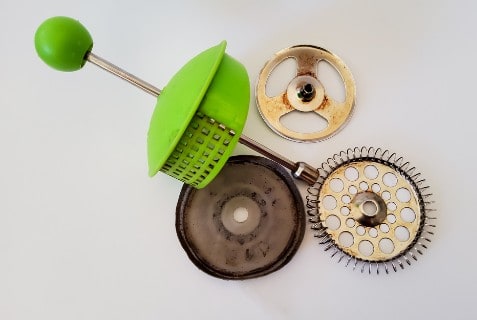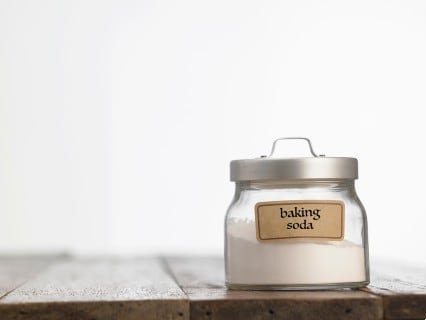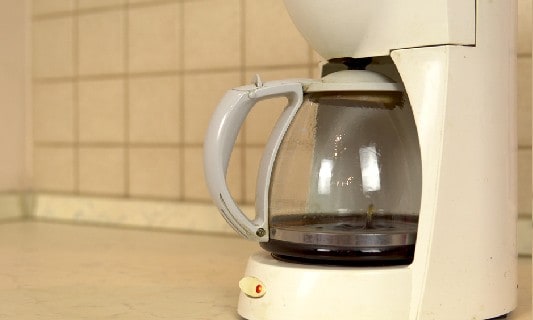How clean do you think your coffee maker is? Do you clean it as regularly as you should or is there mold in the coffee maker? If you are a coffee lover and like to have a cup of perfection every morning, then brewing your coffee in a clean coffee maker is the key.
If you are wondering how to clean a moldy coffee maker, experts suggest using baking soda and synthetic vinegar with the half-and-half technique to get rid of most of the mold build-up in your coffee maker.
That’s not all there is to it, though. To help you out, we have compiled several tips and tricks through which you can easily remove any mold in your coffee maker. Let’s begin.
Table of Contents
- 1 What Happens if You Drink Moldy Coffee?
- 2 How to Know If Your Coffee Maker Has Mold
- 3 How to Prevent Mold in a Coffee Maker
- 4 How Often Should You Clean Your Coffee Maker?
- 5 How to Clean the Water Reservoir in a Coffee Maker
- 6 How to Clean a Moldy Reusable Coffee Filter?
- 7 How Do You Clean a Moldy Coffee Maker?
- 8 Conclusion
What Happens if You Drink Moldy Coffee?
If exposed to the right conditions, coffee, like most consumable items, is prone to mold growth. If mold grows on coffee, it can produce mycotoxins, which are hazardous and harmful if taken in significant amounts.
Drinking moldy coffee can prove dangerous to your health. You may experience nausea, vomiting, and bleeding in the lungs and nose. These symptoms are typically exacerbated by an allergic reaction to black mold spores. Toxic black mold can be costly to remove, and black mold poisoning and exposure can cause a number of health problems, some of which are life-threatening.
How to Know If Your Coffee Maker Has Mold
The majority of modern coffee machines are prone to gathering dust, mildew, and other contaminants in difficult-to-reach places. A coffee maker is also continually exposed to moisture, giving an ideal breeding ground for mold to grow and thrive.

If your coffee smells terrible, tastes unusually bitter, or has developed an unusual texture, then it’s likely you have mold in your coffee maker. You may also have headaches, allergies, gastrointestinal issues, respiratory infections, etc.
How to Prevent Mold in a Coffee Maker
Coffee makers are among the appliances that are most likely to host germs in the house, according to a 2011 assessment by the National Sanitation Foundation. That is because coffee reservoirs are warm, moist environments that mold and yeast love. Here are a few tips for you to help prevent mold growth in your coffee makers:
How Often Should You Clean Your Coffee Maker?
Your coffee machine should be cleaned every two to three months. Several health experts claim that if you use your coffee maker every day, you shouldn’t have to clean it very often. Instead, you should be able to see any mold and bacteria on the brewed pieces, as well as coffee grounds in the brew tank.
How to Clean the Water Reservoir in a Coffee Maker
Start brewing by filling the reservoir to the brim with a half and half vinegar-water solution. Allow for a half-hour of brewing time before shutting off and leaving your coffee machine alone. During this time, the vinegar will work to kill bacteria and mold spores in the appliance’s reservoir.
While you are waiting, dissolve a cup of dish soap in a bowl of water and stir well. This will be used to clean the exteriors of the coffee maker later. Clean the outside of your coffee maker with a damp towel and dish detergent. Check for mold spores on the machine’s exterior.
If at all feasible, scrub the inside of the water reservoir. Keep in mind that the reservoirs on some models are not big enough for this.
How to Clean a Moldy Reusable Coffee Filter?
Remove any parts of your coffee maker that can be removed and wash them. Most variants feature the filter tray as well as any reusable filters. To clean the individual components, scrub them with dish soap and a rag. If your coffee machine has replaceable parts, make sure you take them all out. Finally, before reinstalling the parts in your pot or coffee machine, clean and dry them.

This process is essential, as it helps to remove the remaining coffee grinds and oil. Although most products are dishwasher-safe, hand-washing with warm, soapy water is an option. Remember to wipe down the container’s exterior as well as the heat plate, where spills can burn.
How Do You Clean a Moldy Coffee Maker?
You will end up with some unpleasant residue in your coffee if you do not clean your machine. It is also possible that your coffee machine will produce a foul odor, not unlike your smelly blender. Moreover, poor mold removal might result in clogs and obstructions, causing the machine to malfunction. You can avoid these problems by learning how to clean a moldy coffee maker. Here’s how:
How to Clean a Drip Coffee Maker
Pod coffee machines, like drip coffee makers, are prone to mold growth. One feature that distinguishes these models is the importance of using the brand’s cleaning products regularly. You will also find detailed instructions if you select this option. If you do not want to spend the money on a professional cleaning solution, a mixture of equal parts water and white vinegar can be used to remove mold from a pod coffee maker.
Before you do anything, check the coffee maker’s manual for specific cleaning instructions, as the machine may have unique cleaning settings. If you have lost your physical copy, the internet makes these guides readily available.
Normally, you can fill the reservoir with half and half of water and vinegar. Run the machine as many times as necessary to empty the reservoir, then run it again until two reservoirs of clean water have been drained.
How to Clean a Coffee Maker with Vinegar?
This half and half trick requires you to fill your coffee maker with a half proportion of vinegar and half water. Fill the coffee pot halfway with white vinegar and halfway with water, then replace the filter in the machine. It is important to note that you do not need to add another filter to the tray. After pouring the vinegar and water solution into the water reservoir, place the pot in the coffee machine. Set the coffee maker to brew to allow the solution to pass through.

After the brewing cycle is completed, let the solution sit in the coffee pot for around ten minutes. Take the hot solution from the kettle and pour it out. Make sure to rinse the coffee pot with clear water before using it to remove any remaining vinegar and water solution. This step may need to be repeated three or four times to be thorough.
How to Clean a Coffee Maker with Baking Soda?
It is also suggested to mix a quarter cup of baking soda with a liter of water to remove oils and stains. Fill an appropriate-sized container with hot water and add the baking soda and stir until it is completely dissolved. Now, fill the chamber halfway with the baking soda-dissolved water and set it aside to brew. Rinse the machine with clean water once the brewing operation is completed, and make sure to rinse it thoroughly by repeating the instructions above.

If there are any coffee grounds left in the filter, empty them and discard them. Empty the carafe and clean it with plain water or scrub it with a sponge and dish soap if it has been sitting soiled for too long. Rinse the pot completely before using it to make coffee.
How to Clean a Moldy Keurig
The water reservoir in your Keurig might be dishwasher safe. Remove it and check for those words inscribed on the outside or inside. Run it through a cycle in the dishwasher if it can be washed that way. While that is being cleaned, you can wash the other components by hand.
If your reservoir is not dishwasher safe, mix equal parts white vinegar and water in it. As an alternative, fill the reservoir with water and a quarter cup of baking soda, and then allow the solution a few minutes to work its magic. Scrub the interior and bottom using a toothbrush or a round-tipped brush. As a result, the reservoir and the water intake hole will be cleansed.
If your Keurig coffee maker has never been cleaned or is significantly blocked, you may need to repeat the process. Run plain water through your machine two or three times to eliminate all of the vinegar after you have run the white vinegar solution through it once or twice.
How to Clean an Espresso Machine
One of the most important but often overlooked components of making great coffee is keeping your espresso machine clean. Every superb cappuccino, latte, flat white, or other espresso-based drink starts with a fantastic shot of espresso. To begin, you will clean and descale the interior components of the espresso machine. Before draining the water reservoir, make sure the espresso machine is turned off. Fill your jug with water and one sachet of any cleaning powder. To dissolve the solution, fill the jug halfway with warm water and spin vigorously.
Fill the water reservoir with the cleaning solution and turn on the espresso machine. Once it empties after several runs, remove the water reservoir, clean it with fresh water, and reinstall it with at least two liters of fresh, clean water. Flush freshwater through the group-head and steam wand as you did with the cleaning solution until the water reservoir is empty or only clean freshwater flows through the unit.
How to Clean a Pour-Over Coffee Maker
If your pour-over coffee maker has a musty stench, it is time to figure out how to clean it more thoroughly.
Stains easily appear on the glass or ceramic pour-over carafes. It may be enough to use a bottle brush or toothbrush with a mild detergent to gently scrub the inside surface of your pour-over maker to remove the stains.
If there’s extra grime buildup, put two Alka-Seltzer tablets (or other effervescent tablets) inside, then fill with warm water. Leave the carafe with the solution overnight, then wash the carafe with detergent. After rinsing, let it dry thoroughly.
Although you may clean your dripper’s filter regularly, some stubborn oils and minerals may still accumulate. Mineral scales in particular can be problematic. The buildup will continue despite regular cleaning, especially if you have hard water in your area. If you want to break down the most stubborn minerals and oils, follow these steps once a month.
Boil the filter for 20 minutes in a vinegar:water solution at a ratio of 1:3. Let the dripper soak in the solution for 4-8 hours or overnight. To finish cleaning the filter, wash it with soapy water or put it in the dishwasher.
How to Clean a French Press Coffee Maker
So, you have done your research, bought a high-quality French press coffee maker, and learned how to create the perfect cup of coffee. It is time to clean this teeny-tiny appliance once and for all. You read through the directions, but they are not very useful. Thankfully, cleaning a French press is as easy as preparing a cup of coffee in one.
Start by cleaning your French press coffee maker once a day. For a more thorough cleaning, disassemble the plunger and place all of the pieces on the counter. Clean each item separately with a thin paste of baking soda and water. Scrub the pieces with a sponge or a toothbrush. To clean the coffee maker of hard water buildup, soak the parts in equal parts vinegar and water.
After rinsing the parts out allow your coffee machine to dry thoroughly in the open air. After that, reassemble the French press. You are all set to make some more coffee now!
Conclusion
We hope you found this blog useful and it helps you maintain your coffee maker and keep your machine free from any kind of germs or mold to enjoy a safe and decent cup of coffee. Some of the most effective and fruitful methods are shared above for you to easily clean mold in the coffee maker. Be it using vinegar, baking soda, or brewing consistently, all of these methods are effective and produce great results.

